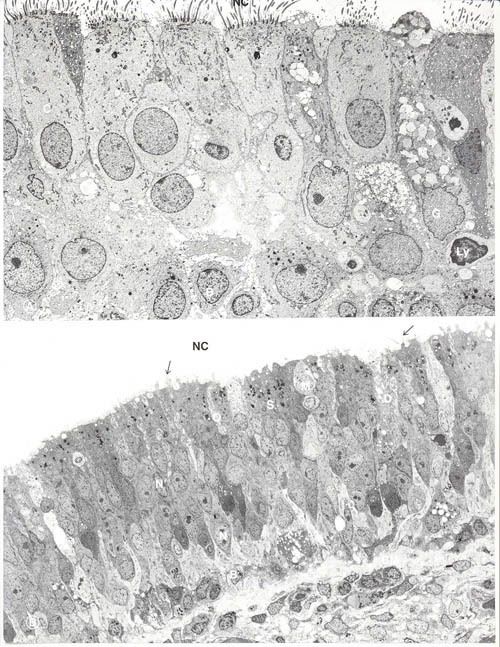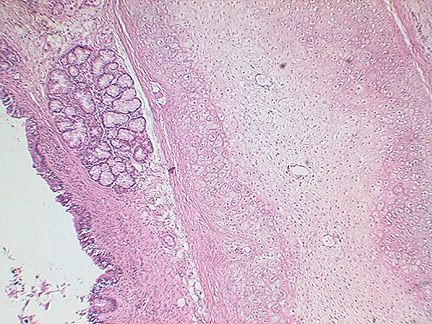Nasal Cavity
 Figure 2: Histological preparation of the nasal cavity. (From http://www.visualhistology.com/Visual_Histology_Atlas/VisualHistology_Atlas_2-0-254_1.jpg)
Figure 2: Histological preparation of the nasal cavity. (From http://www.visualhistology.com/Visual_Histology_Atlas/VisualHistology_Atlas_2-0-254_1.jpg)Air is conducted through the nostrils (or nares) of the nose [6]. The first two centimeters of the nares are called the vestibules and are lined with keratinised stratified squamous epithelium. Note the presence of sebaceous glands throughout this epithelium [5, 6]. Hairs line the vestibules and filter matter out of the airstream. The vestibule opens to the nasal cavity (nasopharynx) and the keratinised stratified squamous epithelium transition first to unkeratinized stratified squamous epithelium and then to ciliated pseudostratified columnar epithelium [1]. This epithelium is characteristic for all conductive respiratory surfaces and is thus also called the respiratory epithelium. Goblet cells, which secrete mucus, are present in this epithelium and mucous and serous glands are present in the connective tissue (lamina propria) under this epithelium [8]. These supplement the secretion of the goblet cells. Veins in the lamina propria are in large sinuses called cavernous bodies. The nasal cavity has bony projections called conchae which increase the surface area of the cavity and cause the air passing through to become turbulent. This turbulence allows the nasal cavity to perform its three main functions: filter the air of particulate matter, warm the air before it enters the pharynx, and moisten the air before it reaches the pharynx [1, 2, 8].
Pharynx

Figure 3: The nasopharynx. (From http://anatomy.iupui.edu/courses/histo_D502/D502f04/Labs.f04/respiratory%20lab/s46.20x.r2.jpg)
The pharynx conducts warm, moist, filtered air from the nasal cavity to the larynx and is divided into three parts [5, 6]. The nasopharynx lies directly behind the nasal cavity and consists of ciliated pseudostratified columnar epithelium [5]. The cilia serve to remove particulate matter from the ventilated air [6]. The oropharynx lies behind the oral cavity and consists of non-keratinized stratified squamous epithelium [5]. The hypopharynx leads into the larynx. The oropharynx and hypopharynx both conduct food as well as air and thus they require the protection against abrasion that non-keratinized stratified squamous epithelium offers [7, 8].
Larynx

Figure 4: The lumen of the larynx. (From http://anatomy.iupui.edu/courses/histo_D502/D502f04/Labs.f04/respiratory%20lab/lary.4x.1.jpg)
The larynx connects the pharynx to the trachea and contains the vocal chords which are used for sound production. The vocal chords are lined with non-keratinized stratified squamous epithelium as well as skeletal muscle in order to control the movement of the vocal folds, which produce sound. Cartilage surrounds the larynx and acts as a support system [7].